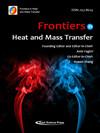THE EFFECTS OF VARIATION IN SHAPE OF SMOKE RESERVOIRS AND NUMBERS AND DISTRIBUTION OF SMOKE EXTRACTION POINTS ON THE TENABILITY WITHIN A COMPARTMENT
IF 0.7
Q4 THERMODYNAMICS
引用次数: 0
Abstract
This study has examined some important aspects of the engineered smoke control system, namely the shape of smoke reservoirs and the quantity and distribution of smoke extract points within a smoke compartment. Three different shapes of smoke reservoirs have been selected for analysis, namely square, rectangular, and T-shaped. The shape of the smoke reservoir has been varied, but the area, length and height have been kept identical. Four different configurations of extract points have been used in each shape of the reservoir: a single extract point located at the corner of the smoke reservoir, a single extract point located at the centre of the smoke reservoir, two extract points evenly distributed within the smoke reservoir and four extract points distributed within the reservoir. These configurations were implemented in three different shaped reservoirs: square, rectangular and T-shaped. The area, length and height of the reservoirs have been kept identical. In this work, the design parameters such as area and length of the reservoir, extract rate of smoke, replacement of air in the reservoir and other parameters have been stipulated from the Singapore Fire Code and Building Research Establishment Report. Fire Dynamics Simulator (FDS) model has been employed for this research, and results show that variations in the shape of smoke reservoirs or quantity and distribution of smoke extract points do have an effect on the tenability within the smoke compartment. Generally, it has been found that the untenable conditions within a square-shaped smoke reservoir increased at the slowest rate, given the fact that the smoke compartment is symmetrically shaped with equal dimensions on all four sides of the compartment. The smoke compartment with the most number of bends, i.e. the T-shaped smoke reservoir, has shown that the untenable conditions increase at the fastest rate, followed by the most elongated shaped smoke compartment (i.e. rectangular). For the other part of the research, results have shown that the provision of four extract points evenly distributed within the smoke reservoir resulted in the most favourably stable smoke layer and the untenable conditions within the smoke compartment increased at the slowest rate. However, one vent in the centre shows a better outcome than two evenly distributed points. It has been exhibited in this research that varying the shape of the smoke reservoirs, the quantity and/or the distribution of smoke extract points does affect its tenability within a smoke compartment. A sensitivity analysis has confirmed these findings.烟雾储存库的形状和抽烟点的数量和分布的变化对舱内可持续性的影响
本研究考察了工程烟雾控制系统的一些重要方面,即烟雾储存库的形状以及烟雾隔间内烟雾提取点的数量和分布。选取了三种不同形状的烟库进行分析,即方形、矩形和t形。烟库的形状虽有变化,但面积、长度和高度保持不变。在储层的每个形状中使用了四种不同的提取点配置:位于烟雾储层角落的单个提取点,位于烟雾储层中心的单个提取点,均匀分布在烟雾储层内的两个提取点和分布在储层内的四个提取点。这些配置在三种不同形状的油藏中实施:方形、矩形和t形。水库的面积、长度和高度保持不变。在本工作中,设计参数如蓄水池的面积和长度、排烟率、蓄水池内空气的置换等参数均参考了新加坡《消防规范》和《建筑研究编制报告》。采用火灾动力学模拟(FDS)模型进行了研究,结果表明,烟雾储存库的形状或烟雾提取点的数量和分布的变化确实会影响烟雾隔间内的可持续性。一般来说,考虑到烟室四面尺寸相等的对称形状,发现方形烟库内的不成立条件增加的速度最慢。弯曲次数最多的烟室,即t型烟库,其无法维持条件的增加速度最快,其次是形状最拉长的烟室(即矩形)。在另一部分研究中,结果表明,在烟雾库中均匀分布的四个提取点导致烟雾层最有利的稳定,烟雾室内的不稳定条件增加的速度最慢。然而,一个通风口在中心显示比两个均匀分布的点更好的结果。本研究表明,改变烟雾库的形状、烟雾提取点的数量和/或分布确实会影响其在烟雾隔间内的可持续性。敏感性分析证实了这些发现。
本文章由计算机程序翻译,如有差异,请以英文原文为准。
求助全文
约1分钟内获得全文
求助全文
来源期刊

Frontiers in Heat and Mass Transfer
THERMODYNAMICS-
CiteScore
2.50
自引率
61.10%
发文量
66
审稿时长
10 weeks
期刊介绍:
Frontiers in Heat and Mass Transfer is a free-access and peer-reviewed online journal that provides a central vehicle for the exchange of basic ideas in heat and mass transfer between researchers and engineers around the globe. It disseminates information of permanent interest in the area of heat and mass transfer. Theory and fundamental research in heat and mass transfer, numerical simulations and algorithms, experimental techniques and measurements as applied to all kinds of current and emerging problems are welcome. Contributions to the journal consist of original research on heat and mass transfer in equipment, thermal systems, thermodynamic processes, nanotechnology, biotechnology, information technology, energy and power applications, as well as security and related topics.
 求助内容:
求助内容: 应助结果提醒方式:
应助结果提醒方式:


